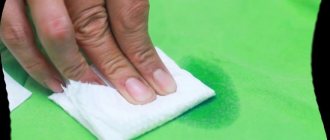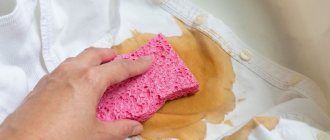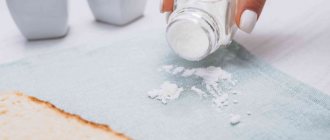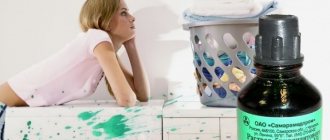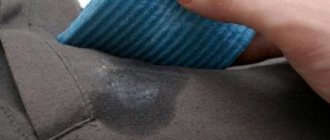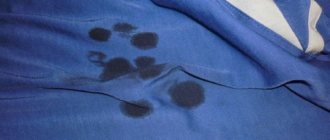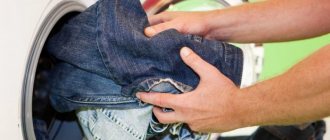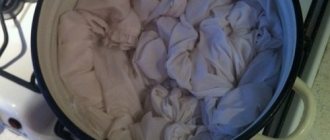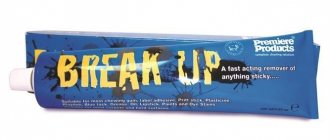No matter how responsible the housewife is, there is always a chance of getting dirty while preparing dishes. While traces of some food are easy to remove, traces of sunflower food are not so easy. We have collected the most effective options on how to remove oil stains and return your things to their original appearance.
Immediate cleaning actions
Let's use what we have, first checking the affected fabric for tolerance to certain cleaning substances. Table salt – sprinkle generously on the stain, gently rub it into the clothes and leave for 5-10 minutes. You can use paper napkins.
Laundry soap works well. To do this you need:
- Pour hot or warm (depending on the composition of the fabric) water into the basin;
- Gently soap the contaminated area;
- Leave to unlock for 2-3 hours;
- Wash in a washing machine.
It will be more difficult if you find yourself visiting, traveling or in a public place. The experience accumulated by more than one generation will help here. Let's try to look at some effective folk methods for removing oil stains.
Methods for removing fresh stains
You can get dirty while cooking, when hot oil splashes, or simply while eating food. How to remove oil stains from fresh clothes? Don't delay, start washing soon. Start cleaning the item right away - you will have to use less chemicals.
Frustrated person pointing to spilled curry stain on white shirt
Salt
How to remove oil from clothes using salt? The flaw in the clothing must be generously sprinkled with salt and pressed into the fabric. Leave the item in a horizontal position, not in the open sun, for up to 40 minutes, shake off the salt.
It is worth checking whether there is any fat left; if so, then repeat the procedure.
Laundry soap
To neutralize oil stains, cover the dirty area with foam. There should be a lot of foam so that the air bubbles completely fill the stain. Let the item soak in soap for about half an hour.
You can soak it in a bowl of warm water and leave it overnight. Rinse in fresh, warm water. Soap should be without obsessive odors.
Chalk, tooth powder or talc
How to remove an oil stain with bulk cleaning ingredients? All of them belong to powder absorbents. Apply and rub with a sponge or toothbrush. Rough pressure can damage the fabric.
After a few hours, the remaining absorbent should be shaken out over the bathtub.
Dish detergent
Do you know how to remove sunflower oil from clothes using detergents? Kitchen products will wash not only dirty dishes, but also clothes. It is necessary to make a solution in warm water with the addition of detergent. Soak the item in this water for a few minutes and wash it.
Can be repeated without pre-drying. To do this, you should use detergents for dishes, and not for ovens or grills, because they contain chemicals that can damage the fabric and the appearance of the product as a whole.
Bleach
Are your white clothes dirty? Then let's get to the bleach. There is a choice - gels, solutions, pencils. In any form, their effect will be the same.
Oily areas should be moistened with warm water and only then treated with bleach, which should be rubbed in with a sponge. Let the item “acidify” for half an hour, then wash the item in soapy water. Choose oxygen bleaches.
Ammonia and turpentine
These components should be used together with warm water. It is worth emphasizing that the entire thing cannot be soaked in the solution. You just need to moisten a cotton pad and use it to treat the contaminated area. Place a piece of cotton fabric on top of the treated area and iron it with hot steam. Wear gloves to avoid damaging the skin of your hands. Also open windows to ventilate the room.
Starch
How to wash vegetable oil with potato starch? The action of starch is to draw out remaining fat; it works in symbiosis with the washing machine. Pour starch onto the inside of the dirty item and rub it in. After 15-20 minutes, remove the remaining starch and soak the item in soapy water. When the item is in the solution, you can gently wring it out and put it in the washing machine. If you do not remove the starch, the item may become rough.
Iron
The iron itself is not so great at dealing with greasy stains, but then how can you remove the stains? Thanks to steam and elevated temperature, the fluidity of the oil increases and it disappears from things. Thick paper is placed on the affected item, and a heated iron is placed on top. When the paper has absorbed oil, change it and continue doing this until it is clean.
Baking soda
Baking soda itself is an alkali that both absorbs and breaks down grease stains. Dry baking soda must be rubbed into the stain. Clean it off after half an hour. If necessary, the procedure can be repeated several times. It is better to use a sponge for rubbing.
Soap and washing powder
First, the area around the contamination must be moistened with warm water. Next, take a barely damp brush and rub the stained area with grated soap or powder. After this manipulation, wet the center to be rubbed with a damp cloth or cloth. Do this until the napkin stops taking on greasy stains. After this, you can use the washing machine.
Glycerin with ammonia
Glycerin is mixed with ammonia, with the addition of a soap solution. The liquid is applied to the fabric. After 30 minutes, wash the item in the washing machine. If it is a large item, then it is washed by hand. It is recommended to work with gloves and a mask.
Table salt for purifying sunflower oil
An easily accessible product that no housewife or catering establishment can do without. It is best to use finely ground “Extra” salt. It easily penetrates the pores of soiled clothing, absorbing oily substances.
The effect may be even better if you place a paper napkin or towel on top of the small crystals and iron it. Salt is chemically neutral, so it will not damage your item upon contact.
Technical oil
It so happens that an unfortunate greasy stain on things appears during the process of repairing equipment, a car, or at work. Most often men face this problem. Marks on clothing in such cases are the result of hydraulic, transformer, Vaseline or any other technical oil getting on the fabric.
Machine oil stains often appear on clothing during equipment repairs.
Oddly enough, the methods for dealing with such contaminants are similar to those used to remove traces of vegetable oils. True, in a work environment it is not always possible to notice a stain in time, and as you know, removing old marks is much more difficult than recently planted ones.
If you were unable to remove the mark the first time, try using several of the components suggested above one by one. If these steps are not successful, contact your dry cleaner for help.
Baking soda for cleaning sunflower oil
It has a weak alkaline reaction, breaking down and adsorbing sunflower oil. To remove stains, sprinkle the powder onto the surface and rub thoroughly into the fabric with a brush. 20-30 minutes is enough to clean the material.
Natural suede is subjected to this procedure, and bulky pile carpets are washed perfectly. A similar result will be obtained when using tooth powder containing chalk instead of soda.
Types and characteristics of oil stains
To remove oil stains from clothes and preserve the color and texture of the fabric, you need to choose the right cleaning product. The result of the procedure also depends on the correct determination of the type of contamination. Oils by origin are:
- Vegetable.
- Animals.
- Chemical.
Regardless of the type of origin, they eat into the material and getting rid of them is quite problematic. The first 2 types of fats can be removed with improvised means, for example, soda or dishwashing liquid; chemical oils affect the internal structure of matter, so only aggressive means can help remove them.
Mustard for sunflower oil purification
During the difficult times of the mid-20th century, this substance was widely used to wash clothes. Modern scented cleaning products have replaced natural powders. Although mustard is still used to effectively remove food stains from kitchen towels. It copes well with oil stains.
You need to take water and mustard powder in equal proportions, mix until a thick paste is obtained and apply to a dirty surface. Wait 20-30 minutes, then clean with a soft brush. Wash clothes as usual.
What can you do first?
Once the oil gets on the item, the main task is to prevent it from spreading. To do this, remove as much as possible: blot with a napkin, then sprinkle with any adsorbent (absorber).
Salt
Sprinkle generously in a thick layer and rub in gently. Remove after 10-20 minutes. If the mark does not disappear, repeat until you get the result.
Dish detergent
Any concentrate will do, since each contains components that break down fats. They pour it over the dirt and keep it for 15-30 minutes when it’s fresh, and longer when it’s dried. If the item can be washed, put it in the washing machine; if not, remove the gel with a damp cloth.
Dentifrice
Sprinkle the oil trail and rub in a little. Leave for 15-20 minutes, brush off, wash clothes. Apply a mixture of powder and water to the dried stain. Leave for 2-3 hours, then remove and wash the product.
Shaving foam
Shake the bottle and spray the foam onto the stained area. Wait 20-30 minutes, remove any residue, wipe the product with a damp cloth or wash it. If necessary, repeat the procedure.
Dishwashing detergent
Fairy, AOC, Drop, Sorti - this is an incomplete list of washing shampoos developed by modern chemists to make work easier in the household.
Their main purpose is the breakdown of organic compounds even in cold water. These products are suitable not only for their intended purpose, but also for removing many fatty deposits.
To clean an oil stain you need:
- Apply washing shampoo to the dirty area and rub into the fabric. The measure of acidity - pH - of such preparations is neutral or slightly alkaline, so there will be no harm to clothing. If the material is still delicate, then try first on the wrong side of the seam;
- Pour water into a small container and wash the item;
- Rinse and dry.
Important! Do not use special grease cleaners for ovens and grills. The nature of the action of the drugs is very aggressive and dangerous for the integrity of even the most resistant paints and fabrics.
How to remove traces of butter and fish oil
These oil stains are difficult to remove. To ensure that not a trace remains of them, it is better to carry out the disposal procedure immediately after the contamination appears. Fatty stains can be easily removed with improvised means and pharmaceutical preparations. The method is selected based on the type of fabric and the period of appearance of unnecessary marks. The desired result is achieved by observing time and temperature conditions.
Dish liquid
It must be chosen with a thick consistency without dyes. The detergent helps eliminate greasy marks thanks to the special components contained in its composition. The stain will disappear from the fabric within 20 minutes after applying some dishwashing liquid to it. A stain on denim items must first be spilled with water, the temperature of which should be above +60°C.
Nail polish remover
Cosmetic liquid solves the problem with fresh traces of fat well. It needs to be applied to the damaged piece of material for 20 minutes, then rinsed in warm water. You should start treating the oil area from the edges and move towards the middle. You can also blot the contaminated surface with liquid, put a piece of paper on top and warm it with a warm iron. When choosing any of the methods, it is important to observe the time and temperature conditions of processing.
Stain removers
You can get rid of oil stains on clothes using a stain remover in 30 minutes. There are 2 ways to get rid of greasy marks:
- Blotting the damaged surface.
- Boiling.
The first method is used to eliminate unnecessary stains from colored materials, the second - from white ones. The contaminated area on fabric with different shades should be wiped with the main product, and the white fabric should be boiled for as long as indicated in the instructions.
Gasoline, benzene, turpentine
To use these solvents, you first need to make a test on the lining or back of the garment. Cotton, linen items or those containing a small percentage of synthetics must be cleaned. The most effective work will be done when potato starch is added to the solvents.
Important! Do not use motor gasoline to remove contaminants. Numerous toxic additives make the fuel itself difficult to remove from any fabric.
For this purpose, you should purchase well-refined gasoline, kerosene or turpentine at hardware stores. Cleaning algorithm:
place a piece of cotton textile or paper towel under the stain;
- Moisten a clean cloth with solvent;
- Wipe the dirty area with a damp cloth from the edges to the center;
- Treat the rim that has formed as it dries with a swab dipped in gasoline.
Features of cleaning suede clothing and shoes
Suede is a soft, thin material that does not have a front layer. Because of this feature, the fabric actively absorbs various types of fats and other contaminants. They cannot be removed with water, otherwise the products will become completely unusable. To preserve suede products, you need to have the following things on hand:
- special brush;
- cotton pad;
- nail polish remover;
- hydrogen peroxide.
Removing an oil stain from clothes or accessories made of suede is simple: you need to soak it with a cotton pad, onto which you must first add a couple of drops of nail polish remover. After the procedure, clean the area of contamination with a special brush and treat with hydrogen peroxide.
Stain removers
When using products specially designed for cleaning clothes and household items, you should strictly follow the instructions to avoid damage.
A variety of household gels, powders, and rollers contain fat breakers, active oxygen, surfactants, flavors and other additives.
An excellent grease remover can be prepared at home.
- To do this, you need to take equal parts of purified gasoline, ammonia and ethyl alcohol or vodka.
- Apply the resulting solution to the oil stain and wait 15-30 minutes.
- If the contamination is old, the time increases to one and a half hours.
- Then you should rinse the item in cold water.
How to remove old oil stains from clothes
Getting rid of a fresh oil stain on clothes is easier. Even the usual “Antipyatin” will help here. Just lather the “blot” and leave it for an hour, then wash the item as usual. But removing dried oil from clothes is more difficult, but also quite possible, even without washing the item completely. Spot-treat the stain with a mixture of ammonia, cold water and fine table salt (1:1:1). If the contamination persists, try one of the following methods.
- Mustard powder. The product must be mixed with water until creamy. It is recommended to wash the item before cleaning. Then the powder is applied to the dirty area for five minutes, after which the mark is rubbed with laundry soap and washed off.
- Refined gasoline. For example, “Galoshes”. A piece of cloth is generously moistened in the solution and placed under the contaminated area. The stain is wiped from above with a clean material. Then the item should be washed.
- Salt. Half a glass of salt is added to a basin of hot water and the dirty item is placed there. You need to leave it for a couple of hours. Then the product can be washed using powder and stain remover.
When choosing a method for removing oil from clothes, always take into account the type of material, type of oil and the aggressiveness of the products used. You can experiment with thick fabrics: one composition does not work - wash the item and try another. But it’s better to save expensive items made from delicate fabrics and outerwear and have them dry cleaned.
Carpet cleaning
What to do if insidious oil spills on your favorite piece of furniture? First, blot the excess product dry with paper towels.
Next, laundry soap and washing powder will be used:
- Place a piece of polyethylene under the carpet, and then any clean cloth to avoid damage to the floor covering;
- Moisten the surface of the dirty layer and a little around it with water so that the stain does not increase;
- Take a stiff brush, soap it or add a little powder;
- Rub the detergent into the pile;
- Rinse and blot the clean item with a dry cloth.
Regular wash
There are a number of products (both industrial and household) with which we can remove fat from ordinary clothes that do not require gentle washing or hand washing.
Industrial stain removers and quality detergents are designed to dissolve oil and grease.
- Apply one or the other to the stain and let it sit for at least half an hour.
- Then we take the linen in our hands and rub the fabric vigorously against each other under running hot water.
- Finally, put the clothes in the washing machine and wash according to the instructions on the label.
- Many argue that if dish soap degreases the pan, it should also work on the grease on the fabric.
- Therefore, apply a colorless preparation to the dishes on the stain and clean in a circular motion with a brush.
- Then rinse the product with vinegar or hot water.
If the stain does not disappear, repeat the procedure. Once the stain is no longer visible, we put the clothes in the washing machine and wash them at the highest temperature the clothes can withstand.
Some Caveats
It is much easier to remove fresh dirt from the surface than dried and crusted dirt.
When working with any fabric, do a test test on the wrong side of the seam or hem of the fabric. Be careful with delicate material.
Do not use plumbing cleaners. They are too aggressive.
When using stain removers, carefully read the instructions - the chlorine they contain will permanently ruin any item.
When working with solvents - gasoline, turpentine, ammonia, use hand protection and do not forget to open the windows.
Removing old stains
The methods described above work well for relatively fresh stains. If the grease stain is old, more aggressive means will be required to combat it.
- Acetone. This drug will eat away any greasy stain, even if no one knows the moment of its appearance. It is enough to wipe the contaminated area with a cloth or cotton swab, generously moistened with acetone, then wash. However, it has a significant drawback. Acetone dissolves not only fat, but also many dyes, as well as some synthetic materials.
- Ethanol. You can use some other types of alcohol, but this one is the most accessible - sold in any pharmacy. Alcohol also dissolves fats well, but unlike acetone, it does not spoil the material or remove dye from clothes. Stains are removed with a cloth or cotton wool soaked in alcohol. The process will take some time, but do not overdo it. Rubbing the fabric for too long does not make it any better.
- Petrol. This is a fairly aggressive product and before starting to use it, it is better to conduct a preliminary test on an inconspicuous area of the material being cleaned. Contaminants are removed in the same way as with alcohol or acetone. That is, soak a cloth or cotton swab in clean, high-quality gasoline and wipe the vegetable oil stain.
- Specially developed stain removers. Relatively expensive but effective drugs for combating old traces of fat. There are also cheap analogues, the use of which cannot always guarantee a satisfactory result.
Additional ways to remove oil - video:
Photo instructions on how to wash sunflower oil
Traditional methods
Most often they prefer to eliminate complex stains using traditional methods. Using these methods, you can remove complex stains, which include stains left by machine oil.
You can use various powders, kerosene, toothpaste or other substances for these purposes. Before using one or another method, it is recommended to make sure that it will not harm the fabric from which the clothing is made.
Dishwashing liquid
Often people who think about how to remove machine oil from clothes first try to use dishwashing detergent. This method will be effective on fresh stains and is suitable for clothing made from both natural and synthetic fabrics.
The process of cleaning things in this way is divided into several stages:
- Initially, a small amount of dishwashing gel is applied to the stain;
- the clothes are left in this state for about half an hour;
- then the item is erased.
Kerosene or solvent
You can remove oil stains from clothes using this method quickly and effectively if you use it right away. Motorists consider this method universal, since it can be used to cope with any complex contaminants.
Usually they resort to this method if they cannot deal with the stain using more gentle methods. To implement it, the following actions are performed:
- Initially, a small amount of kerosene or solvent is applied to the area where the stain is;
- It is advisable to use a cotton swab;
- use a paper napkin to collect the resulting fat, and you need to move towards the center from the edges of the stain;
- Then the item is thoroughly machine washed at high temperature, taking into account the mode suitable for the specific type of fabric.
This method helps get rid of stains in most cases.
White chalk
This folk method is recommended for fresh stains. How to remove stains on clothes using white chalk? To do this, perform the following steps:
Initially, the chalk must be crushed well to obtain fine crumbs
It is poured directly onto the site of contamination; you need to wait about 20 minutes; after this, the remaining chalk is carefully removed; clothes are washed in warm water, where it is recommended to add a little soap first; To completely remove stains, it is advisable to wash the item of clothing thoroughly in a machine. Chalk is an inexpensive natural dye that can be used to quickly and without damage remove complex stains from delicate fabrics.
You can even use it on denim, and often the result is really high quality.
Chalk is an inexpensive natural dye that helps remove complex stains from delicate fabrics quickly and without damage. You can even use it on denim, and often the result is of really high quality.
White chalk works great on oil stains
Gasoline
Only purified gasoline should be used for these purposes, so it is not recommended to drain it from the gas tank. The product used for refilling lighters works well.
Removing gasoline stains from clothes is quite easy:
- Initially, two cloth napkins are moistened with gasoline;
- one napkin is placed under the stain;
- the other is placed on top;
- you need to wait about 40 minutes;
- gasoline has the ability to absorb oil, so after it dries, the stains are removed;
- the procedure can be repeated several times.
At the end of the procedure, you need to rinse the item under warm water, and it is also advisable to sprinkle baking soda on the treated area. It is left on the fabric for 10 minutes, after which it is recommended to wash the item in a machine.
Mustard powder
This method is not considered very popular, but with its help you can remove even an outdated stain. To do this, sprinkle the desired area of fabric with powder. Next, wipe the fabric with a brush dipped in soapy water. This method is suitable for durable and inexpensive items.
Toothpaste
For fresh machine oil stains, you can use standard toothpaste, so there is no need to look for different complicated cleaning methods.
We remove stains using this simple method:
- apply the paste directly to the stain;
- Next, you need to leave the thing until the paste is completely dry;
- the remaining product is cleaned off with a toothbrush or other instrument;
- After this, the clothes must be washed in a machine.
Mistakes to Avoid
In order not to harm the product by inept cleaning, you need to remember that when removing greasy stains you cannot:
- try to wash the fabric without first treating the contaminated area;
- use products that are not suitable for this type of fabric;
- use too hard brushes;
- dry the product in a machine without ensuring that the stain has been completely removed;
- Use colored cleaning products: dyes can damage the fabric being treated.
The problem of cleaning clothes from oil stains can be dealt with using an arsenal of numerous folk methods and household chemicals. By choosing from them those that are most suitable for a particular fabric, you can get rid of both fresh and stubborn dirt. If you still haven’t been able to remove the unattractive grease stain, you shouldn’t give up and say goodbye to your favorite item: in this case, you can resort to dry cleaning services.
Rate this post
Types of oils
There is a certain classification of oils. There are different types:
- easily soluble and sparingly soluble;
- non-drying, semi-drying and drying;
- oils of animal, vegetable and technical origin.
The most common types of oils should be considered:
- Sunflower oil of vegetable origin is obtained from sunflower seeds, semi-drying. The most used oil in cooking, it is used for dressing salads, frying, and stewing. It is also used in everyday life, for example, to lubricate locks, handles, and door hinges. Also used in the production of soap and other products.
- Vaseline oil is a purified fraction of petroleum, which is obtained after the distillation of kerosene. Hardly soluble substance, non-drying. Widely used in the medical, pharmaceutical, and food industries for lubricating equipment. Included in creams, ointments, lipsticks.
- Flaxseed oil of vegetable origin, drying. It is used both in medicine and in cooking, and also in cosmetology. In medicine, it is used to replenish the level of unsaturated fatty acids necessary for the body. In cosmetology it is used as a component of anti-aging creams, face and body masks. In cooking - as a salad dressing, and also add a piquant taste to the dish.
Hydraulic oil is a technical, semi-drying, complex substance
This is an important component for any hydraulic system. Used in casting machines, presses, heavy manipulators, machine tools, robots, plastic molding machines and many other industries.
Transformer oil is a refined fraction of petroleum, which is mineral oil
It is obtained after the distillation of oil, when the fraction boils at 300-400 degrees Celsius. The main property of this oil is electrical insulation.
Castor oil is a vegetable oil extracted from the fruits of the castor bean plant and is a mixture of glycerides of ricinic, linoleic and oleic acids. It is actively used in medicine against various ailments. There are also legends on the Internet about the magical properties of the oil, so they began to use it in cosmetology to enhance the growth of hair and eyelashes.
- Lamp oil. Everyone knows about its use in churches, since the Lord commanded that oil be burned in a lamp. Lamp oil was previously called wooden oil in another way. Currently, it is used in medical practice in the form of a mixture of purified oils.
- Transmission oils are lubricating oils used to lubricate gearboxes, transfer cases, final drive axles, steering mechanisms and much more.
- Vegetable oil is a group of oils that is allowed for consumption on some days of religious fasting. These are sunflower, corn, mustard and other vegetable oils.
Tips and tricks
- When removing grease stains, flammable agents such as gasoline, acetone, ammonia and others are often used. In addition, these substances are also found in purchased household chemicals. Therefore, when using these components, you must be careful and careful, and carefully follow safety precautions.
- Throughout the entire removal procedure, you should use rubber gloves and safety glasses. This will help avoid possible negative consequences.
- When carrying out the cleansing procedure using the above-described means, be sure to open the doors and windows. This will create a passing draft and prevent dangerous vapors from accumulating.
- All cleaning products must be stored in tightly closed containers and in hard-to-reach places to prevent the container from falling into children's hands.
Thus, you can get rid of greasy stains on clothes using traditional methods or a variety of chemical household products. The main thing is to start cleansing as quickly as possible, using available ingredients.
Adviсe
Use solvents wisely, as they have many negative effects: they evaporate quickly, if you use a large amount, they can ruin the structure of the fabric, the color of the product, and after such a procedure you may feel unwell. Also, sometimes an oil bottle or dispenser is needed in the household. Cleaning the bottle is simple; all you need is a dish brush and detergent. It is enough to pour a certain amount of the substance inside the bottle, add warm water and, using a brush, clean the bottle of oil with progressive movements.
To learn how to remove oil stains, watch the following video.

